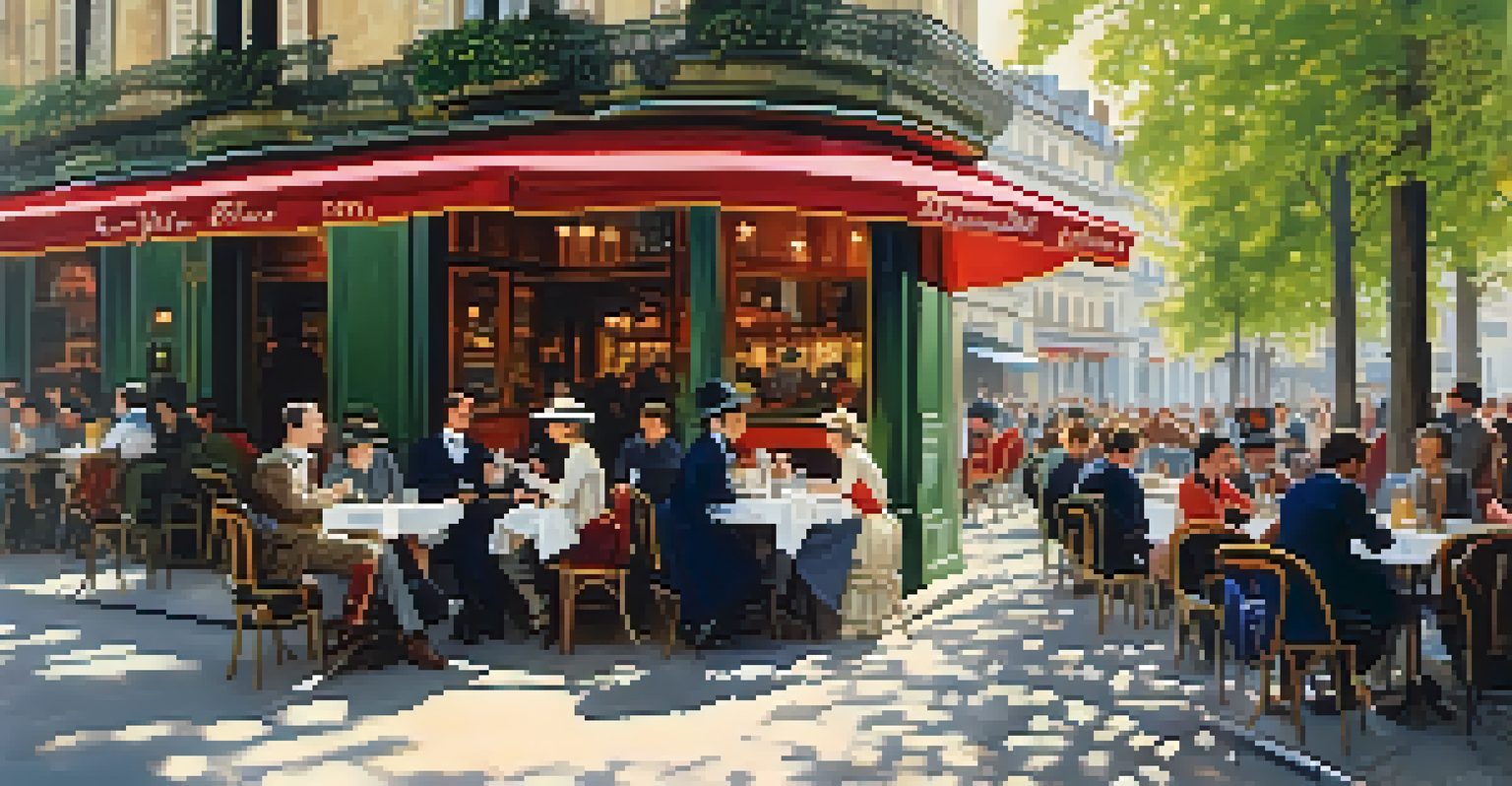The Impressionist Revolution: Manifestos of Light and Color

Understanding the Essence of Impressionism
Impressionism, emerging in the late 19th century, was a groundbreaking movement that changed the art landscape forever. Artists sought to capture the fleeting effects of light and color in their work, stepping away from the rigid, detailed styles of academic painting. This shift allowed for a more personal expression of the world around them, emphasizing perception over reality.
Impressionism is not a movement, it is a way of seeing.
The term 'Impressionism' itself was derived from a derogatory comment about Claude Monet's painting 'Impression, Sunrise.' Critics initially dismissed these artworks as mere sketches, but they soon realized the depth and beauty behind them. This movement was about embracing the moment, focusing on how light transformed everyday scenes, from bustling streets to serene gardens.
Impressionist artists, including Monet, Renoir, and Degas, often painted en plein air, or outdoors, to capture the essence of the moment. This practice was revolutionary at the time, as it encouraged spontaneity and a connection with nature. Their works invite us to experience the world through their eyes, highlighting an emotional resonance that traditional art often lacked.
The Key Players of the Impressionist Movement
At the forefront of the Impressionist movement were a group of innovative artists who shared a vision of breaking free from traditional constraints. Claude Monet, often called the father of Impressionism, focused on light and color, capturing the same scene at different times of day to show the changing effects of light. His series paintings, like those of haystacks and water lilies, exemplify this dedication to exploring perception.

Other notable figures included Pierre-Auguste Renoir, who infused his works with warmth and vibrancy, often depicting joyful social scenes and the beauty of everyday life. Edgar Degas, while associated with Impressionism, had a unique approach, focusing on movement and the human figure, particularly in ballet scenes. Each artist brought their individual style, yet they all shared a commitment to exploring light and color in revolutionary ways.
Impressionism Redefined Art
The Impressionist movement broke away from traditional art styles, focusing on light and color to create a more personal expression of the world.
The camaraderie among these artists was crucial as they often exhibited together, defying the established art institutions of their time. They organized independent exhibitions, allowing them to showcase their work without the constraints of traditional galleries. This collaborative spirit not only solidified their legacy but also paved the way for future generations of artists.
The Role of Light in Impressionist Art
Light was more than just an element in Impressionist art; it was the lifeblood of their creations. Artists experimented with color and brushstroke techniques to depict how light interacts with objects and landscapes. This focus on light helped to evoke mood and atmosphere, turning ordinary scenes into extraordinary experiences.
Color is my day-long obsession, joy, and torment.
For instance, Monet’s 'Impression, Sunrise' illustrates how light can transform a simple harbor into a breathtaking display of colors and reflections. The quick, loose brushstrokes not only capture the essence of the scene but also the ephemeral quality of light itself. This approach encouraged viewers to engage with the artwork on a deeper level, experiencing the moment as the artist did.
Additionally, the use of complementary colors enhanced the vibrancy of their paintings. By placing colors opposite each other on the color wheel, Impressionist artists created a shimmering effect that mimicked the play of light. This technique contributed to the movement’s signature style, making their works instantly recognizable and emotionally resonant.
Color Theory and Its Impact on Impressionism
The Impressionists revolutionized the use of color in art, moving away from the muted palettes of their predecessors. They embraced vibrant, pure colors straight from the tube, applying them in bold strokes to convey emotion and energy. This shift not only changed their individual works but also influenced the broader art community.
Artists like Vincent van Gogh, though not formally part of the Impressionist group, adopted similar color theories that emphasized emotional expression. His dynamic use of color and bold brushwork echoed the Impressionists’ quest for capturing the essence of a moment. This connection shows how the movement's influence extended beyond its immediate circle, shaping modern art as a whole.
Key Figures Shaped the Movement
Artists like Monet, Renoir, and Degas led the Impressionist movement, each contributing unique styles while collectively challenging established art norms.
Moreover, the exploration of color theory allowed these artists to convey depth and perspective in innovative ways. By juxtaposing warm and cool colors, they created a sense of dimension that added to the overall impact of their paintings. This pioneering approach to color continues to inspire contemporary artists, proving the lasting legacy of the Impressionist revolution.
The Significance of En Plein Air Painting
En plein air painting, a hallmark of the Impressionist movement, involved creating artworks outdoors rather than in a studio. This practice allowed artists to capture the changing light conditions and atmospheric effects directly from nature. The spontaneity of this approach led to a sense of immediacy and authenticity in their work.
Monet's experiences painting outdoors, especially in his garden at Giverny, exemplify the beauty of this practice. He would set up his easel and paint the same scene multiple times throughout the day to document the shifting light and colors. This dedication to observing nature in real-time became a defining characteristic of Impressionist art.
The en plein air technique not only transformed the artists' approach but also changed how the public perceived art. Viewers began to appreciate the raw, unfiltered beauty of nature captured in these works. This connection to the environment fostered a greater appreciation for the natural world, a theme that resonates strongly in modern art and conservation efforts today.
The Challenges Faced by Impressionist Artists
Despite their revolutionary contributions, Impressionist artists faced significant challenges during their careers. Initially, they were met with harsh criticism from art critics and the established art community, who viewed their work as unfinished and chaotic. This backlash often discouraged them, but it also fueled their determination to continue experimenting.
Many Impressionists struggled financially, as their unconventional styles did not appeal to traditional art collectors. They often relied on each other for support, forming a community that encouraged innovation and collaboration. This camaraderie was vital in helping them navigate the tough art market of the time.
Enduring Influence on Modern Art
The legacy of Impressionism continues to inspire contemporary artists, influencing various movements and fostering a deeper appreciation for nature in art.
Over time, as the public began to appreciate the beauty and emotional depth of their work, perceptions started to shift. The Impressionists eventually gained recognition, paving the way for modern art movements. Their journey underscores the importance of resilience and staying true to one's artistic vision, a lesson that remains relevant for artists today.
The Lasting Influence of Impressionism on Art
The Impressionist revolution left an indelible mark on the art world, influencing countless movements that followed. Post-Impressionism, Fauvism, and even Abstract Expressionism drew inspiration from the techniques and philosophies pioneered by the Impressionists. Their emphasis on color and light transformed art into a more personal and emotional experience.
Contemporary artists continue to explore themes introduced by the Impressionists, adapting them to express their unique perspectives. The focus on capturing moments and emotions resonates strongly in today’s artistic landscape, where personal narratives often take center stage. This legacy demonstrates how the original Impressionists forever changed the trajectory of art.

Additionally, the movement encouraged a greater appreciation for outdoor and landscape painting, inspiring numerous artists to connect with nature through their work. As a result, Impressionism not only revolutionized the way art was created but also how it was perceived, solidifying its place as a cornerstone of modern art history.